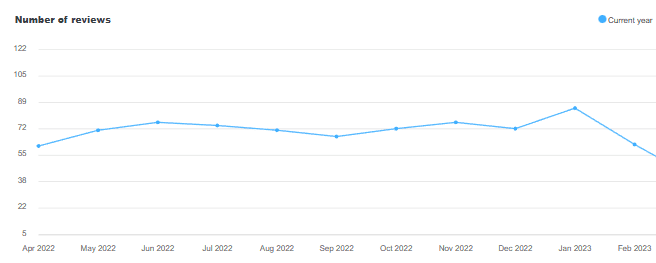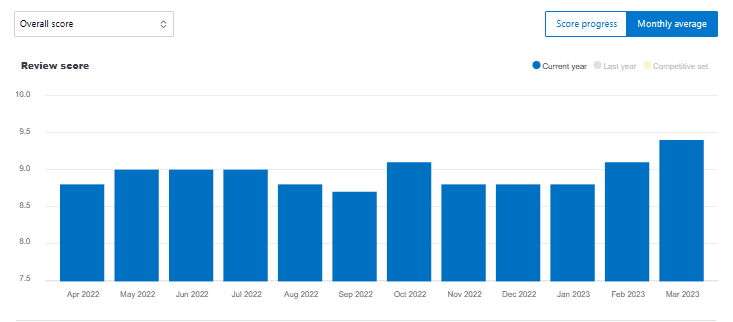
Do you base your room rates on emotions or science? Some hoteliers rely more on subjective feelings than data.
For example, some hoteliers think there’s a correlation between low rates attracting undesirable guests or a ceiling on their rack rate.
Professional revenue managers know otherwise. No data links low room rates with undesirable guests; in fact, it’s the opposite. When people feel like they had a fantastic stay at a great rate, they’re likely to write glowing reviews on OTAs.
Those OTA reviews boost your property’s visibility and attract guests.
Likewise, data shows there’s no limit to the rack rate if the demand is there. Revenue managers use data to predict market rates, not feelings.
A guiding principle of revenue management
An important element of revenue management is the practice of optimizing online visibility and brand reputation. Yes, you may lower room rates in times of low demand, but there’s a strategic reason.
The reason isn’t necessarily to sell the room (yet that does help with cash flow); it’s to boost the hotel’s online visibility. When guests stay in your hotel and feel like they got a great value, they leave positive reviews. These reviews improve your OTA score so more people see your hotel and have the option to book themselves.
Then, as high season approaches, you can raise your rates without losing visibility.
With the right combination of revenue management, hotel quality, and external factors in play, you can sell 3-star hotel rooms for 1000 euros!
We’ll share that case study below, but first, let’s address why low rates boost a property’s reputation instead of lowering it.
Low rates can improve the property’s reputation, not harm it
When your property maintains high scores on Booking, TripAdvisor, and other OTAs, then it stays visible to potential customers. Revenue managers know visibility means positive reviews, higher rates in periods of high demand, and higher revenue at the end of the year.
There’s a specific revenue management strategy to follow in low season to help achieve this visibility. That strategy is to use historical data to lower room rates when there’s not much demand. Instead of letting your rooms sit empty, you find a rate that covers your costs and attracts guests.
Some hoteliers fear low rates attract undesirable guests who may damage the property or be rude to other guests. Yet, that’s a feeling and not a data-backed reason. Guest quality depends on character, not money.
Every hotelier and front-line workers experienced a rude guest or one who flouts the rules (for example, smoking in the rooms) or complains about everything. Many hoteliers shrug off if these guests have paid a higher price.
With revenue management, you can focus on matching your room rates to the demand cycle in low season, maintain high visibility on OTAs, and command higher prices during peak demand.
There’s no price ceiling
With the right combination of market conditions, hotel quality, and revenue management, a 3-star hotel can sell rooms for 1000 euros.
You’ll receive good reviews if your surroundings and service quality match guest expectations.
Of course, many factors must align to achieve such rates, but it is possible. If your staff is well-trained, your furnishings are up-to-date, and there’s an event in town causing a shortage of hotel rooms, yes, you can push your rack rate beyond your imaginings.
Instead of letting subject fears set your rack rate, rely on the science of revenue management.
Revenue management-led pricing decisions can lead to good reviews on the OTAs.
How to handle negative reviews
It’s normal to receive some negative reviews when running a hotel, and some of those reviews may be useful. For example, if guests complain the rooms are musty, find out why. If people complain about the mattresses or rude staff, replace the mattresses and train your staff.
Negative reviews are an opportunity to see how your guests perceive your hotel. Revenue management helps you improve revenue and cash flow to reinvest in refurbishment and staff training.
There’s no need to limit your hotel’s potential.
Revenue management improves your online reputation score and books more guests at higher rates
OTA reputation scores come from the average of your online reviews, and it pulls from years of reviews to calculate your score.
Hotels with a 9 on Booking.com or a 4.5 on TripAdvisor have frequent and recent reviews.
Attracting reviews year-round, even in low season, ensures your property stays visible in high season. Your reputation score will increase as long as you have more positive reviews than negative ones.
Revenue management creates the conditions for the volume of positive reviews to exceed the negative ones. Of course, someone needs to monitor those reviews and reinvest money into the hotel’s appearance and service.
These graphics show a 3-star hotel’s dashboard over 12 months as a case study. This is a Milan-based hotel customer of Franco Grasso’s Revenue Team, and you can see the occupancy has been nearly 100% throughout the year. Of course, there are some fluctuations in ADR (Average Daily Revenue), particularly in June and September when there was exceptionally high demand in the area.
 Some months attract more reviews than others, and there are some negative reviews due to pricing. Yet, the positive reviews overshadow the negative ones because many positive reviews accumulated during the previous and following months. These reviews keep the hotel’s reputation strong.
Some months attract more reviews than others, and there are some negative reviews due to pricing. Yet, the positive reviews overshadow the negative ones because many positive reviews accumulated during the previous and following months. These reviews keep the hotel’s reputation strong.

 Below, you can see the overall Booking.com score remained stable (9) throughout the year. Their visibility remains high and contributes to bookings, occupancy, and ADR.
Below, you can see the overall Booking.com score remained stable (9) throughout the year. Their visibility remains high and contributes to bookings, occupancy, and ADR.
This graph shows the average score of all the reviews received in the last three years.
 The results were much better in 2022 than in 2019 in terms of both Occupancy and ADR
The results were much better in 2022 than in 2019 in terms of both Occupancy and ADR


In 2022, the results improved. The hotel committed to following revenue management principles to boost its online visibility and overall annual revenue.
Take your bottom and rack rates. You won’t sell rooms below a minimum (your bottom rate.) While variable costs can affect your bottom rate, you may not have considered the variables that can impact your rack rate and push it higher than you thought possible.
That’s the purpose of revenue management. It uses science, not emotions, to establish room rates. If the conditions are suitable for a 3-star hotel to sell for 1000 euros, why not accept it? Timing, location, and hotel reputation make the difference.
For more insights about revenue management, download this free guide.
































